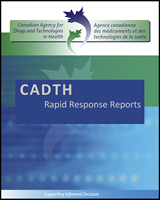| Cicero16 |
|---|
Objectives clearly described The large SKIP sample was likely reasonably representative of a study of opioid abusers, drug use representative of real-life abuse rather than controlled clinical conditions. Data was from a large database sample. Basic patient characteristics described
|
The smaller RAPID sample (more detailed questionnaire of 244 people) may not be representative of the full population as they self-selected into answering the survey. Exact interventions (dosing etc.) not described. Descriptive study – therefore, cannot determine causality. Unclear if the results generalize to a non-treatment seeking population
|
| Degenhardt8 |
|---|
|
|
Descriptive observational study – cannot determine causality – study was hypothesis generating. Those who visit safe injection sites or needle exchange programs may not be representative of all drug users. Time period examined may not be lengthy enough to determine long-term changes in use
|
| Larochelle17 |
|---|
Patients were able to enter and exit the cohort over the 10 year period. Objectives, main findings, patient population clearly described. 95% confidence intervals presented
|
|
| Cassidy18 |
|---|
Methods clearly described. Outcomes were clearly described and defined Model adjusted for potential covariates Steps taken to minimize geographical, and other covariate confounding
|
Estimates using logistic regression Those seeking treatment may not be representative of the entire drug using population Power calculation not reported, however there was a large sample size so power was not likely an issue.
|
| Havens19 |
|---|
Authors explored factors related to the time of the interview and whether that would result in confounding bias. Single interviewer was used so if events were misclassified, they were likely consistently misclassified. Self-reported drug use is considered a valid measure of drug use; 30 day time frame was likely short enough to reduce problems with recall.
|
Recall bias a potential issue due to being a self-reported survey – used anchoring to attempt to reduce recall bias. Population being studied lived in an area where opioid abuse was considered epidemic – may not be generalizable to other populations.
|
| Michna7 |
|---|
Objectives, methods, outcomes clearly described. Classification of exposures well described. Sensitivity analyses performed in order to control for potential confounders (time, primary opioid, coding of abuse)
|
|
| Rossiter20 |
|---|
Objectives, measures, interventions clearly described. Same inclusion and exclusion criteria applied to all included patients Pre- post- formulation change acted as a way to match patients; population-based study allowed for analyzing a large portion of users; pre-post- acted as a quasi-experimental design. Authors allowed for a washout period. Cases and controls well-matched Outcomes unlikely to be misclassified.
|
No randomization. Assumed that continuous and non-continuous users were the same. Non-experimental design – cannot assume causation. Number of people abusing or misusing opioids likely underrepresented.
|
| Sessler21 |
|---|
Sensitivity analyses conducted ( included prescription numbers, reporter type or source, formulation specificity, missing date of death, and reporting time lag) Authors examined non-fatal reports and comparator reports and determined that there was no temporal bias. Outcomes were validated, definitions of outcomes well reported.
|
No randomization Possibility that not all fatalities associated with oxycodone use were coded as such. Voluntary reports of adverse events do not capture all events. (However, there was a large magnitude of change, and reporting of other adverse events did not decrease, therefore, it is more likely that the change seen was a real change and not a change in the way events were reported) Longer-term follow-up may be needed to capture more permanent changes in death rates.
|
| Butler22 |
|---|
Sensitivity analyses conducted using a national database. Objectives, measures, main findings clearly described Selection bias unlikely to account for changes in oxycodone but not other opioids. Data was collected uniformly across time and collection sites. Steps were taken to reduce reporting bias (pictures of the different formulations were shown to patients in order to accurately identify which drug was taken) Confidence intervals, exact P-values reported. Steps taken to minimize geographical, and other covariate confounding.
|
Patients being assessed for substance abuse may be different from other oxycodone users Results may not be generalizable to the general population of prescription drug abusers. Relied on self-reported data. Not randomized May not reflect patterns of abuse of the new formulation after more time has passed.
|
| Coplan23 |
|---|
Objectives, methods, main findings clearly described. Exposure classifications well described Confidence intervals and exact P-values reported
|
Possible that changes in poison centre reporting, misclassification of original or ADF oxycodone occurred during the study period Unclear if there was a representative sample, however, it was a large national sample.
|
| Severston24 |
|---|
Large percentage of the US population was part of the surveillance. Therefore the results are likely generalizable to the US population. 95% confidence intervals and exact P-values reported. Demographic characteristics (such as gender, ethnicity, and age) of the source population did not change throughout the study.
|
Is a descriptive study, therefore it is difficult to determine causation. Depended on voluntary reporting and therefore it is likely that not all cases were reported. Misclassification of product exposure was possible. Other interventions (such as prescription drug monitoring programs) may gave accounted for some of the reductions in abuse.
|
| Butler25 |
|---|
Objectives, methods, main findings clearly described. Exact P-values reported Population likely fairly representative those seeking treatment.
|
Self-reported data – recall bias possible, however, patients entering treatment tend to report fairly accurately. May not generalize beyond patients seeking treatment and who have access to a treatment facility. Descriptive study, therefore cannot determine causality.
|
| Rintoul26 |
|---|
Objectives, methods, main findings clearly described. Confidence intervals and exact P-values reported.
|
|
| Roxburgh2 |
|---|
|
|
|

